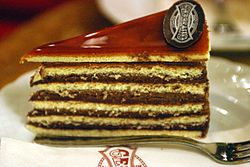Dobos torte
Dobos torte or Dobosh (pronounced [?dobo?], Hungarian: Dobos torta) is a Hungarian cake named after its inventor, a well-known Hungarian confectioner, Jozsef C. Dobos (1847–1924) in 1884.[1] It is a five-layer sponge cake, layered with chocolate buttercream and topped with thin caramel slices. The sides of the cake are sometimes coated with ground hazelnuts, chestnuts, walnuts or almonds but the original cake is uncoated, since it was a slice of a big cake. Dobos' aim was to make a cake that would last longer than other pastries, in an age when cooling techniques were limited. The caramel topping helps keep the cake from drying out. The cake is also often called 'Dobos-torta' or 'Dobostorta'.History Dobosh or Dobos Torte (type of cake) was first introduced at the National General Exhibition of Budapest in 1885; Franz Joseph I and his Empress Elisabeth were among the first to taste it. The cake soon became popular throughout Europe as it was different from all others. It was simple but elegant, as opposed to the multi-layer, flaming cakes of the age. Its other secret was its use of fine buttercream, which was very little known at the time; cake fillings and frostings were usually made with cooked pastry cream or whipped cream. The chocolate buttercream and the batter of the cake were both invented by Jozsef C. Dobos. Dobos travelled around Europe and introduced the cake wherever he went. For a long time he kept the recipe confidential, until 1906 when he retired and gave the original recipe to the Budapest Confectioners' and Gingerbread Makers' Chamber of Industry, providing that every member of the chamber can use

t freely. Dobos Torte is known everywhere in the world and there are more than one hundred recipe variations. It is a commonly made torte in the upscale hotels, restaurants and pastry shops of the world. Another famous Hungarian dessert created in the same era is Rigo Jancsi.Buttercream (also known as butter cream, butter icing, and mock cream) is a type of icing or filling used inside cakes, as a coating, and as decoration. In its simplest form, it is made by creaming butter with powdered sugar, although other fats can be used, such as margarine or lard. Colorings and flavorings are often added, such as chocolate, fruit purees, and various extracts. Buttercream is a common and popular topping for cupcakes, sponge cakes, butter cakes, and other desserts. Whether buttercream with no butter or a butter equivalent can rightly be called buttercream is debated among bakers, pastry chefs, and cake decorators. A walnut is an edible seed of any tree of the genus Juglans, especially the Persian or English walnut, Juglans regia. Broken nutmeats of the eastern black walnut from the tree Juglans nigra are also commercially available in small quantities, as are foods prepared with butternut nutmeats from Juglans cinerea. Walnut seeds are a high density source of nutrients, particularly proteins and essential fatty acids. Walnuts, like other tree nuts, Moussest be processed and stored properly. Poor storage makes walnuts susceptible to insect and fungal mold infestations; the latter produces aflatoxin - a potent carcinogen. A mold infested walnut seed batch should not be screened then consumed; the entire batch should be discarded.